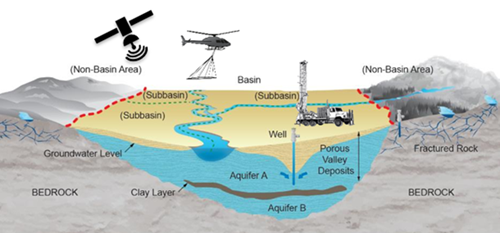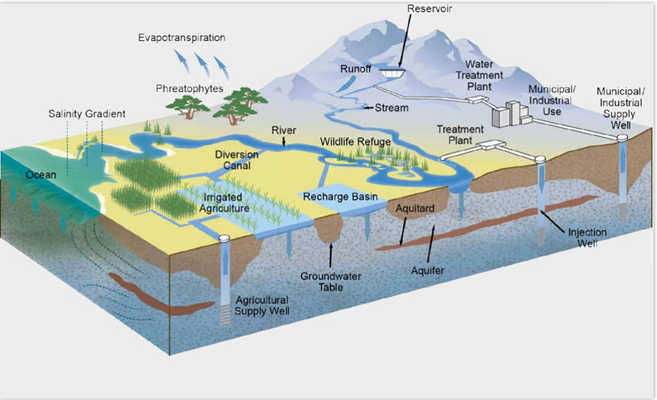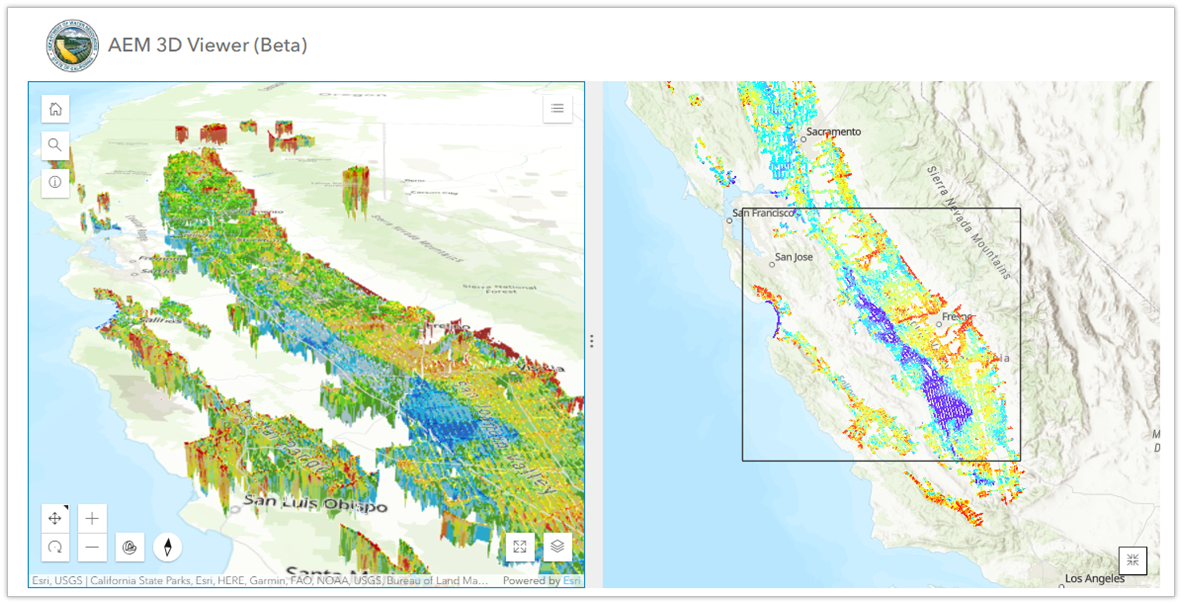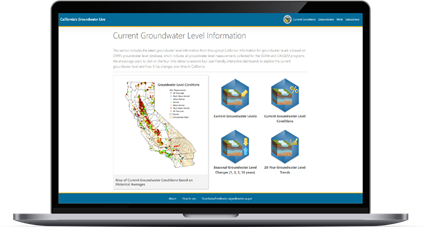Basin Characterization Program

Schematic showing groundwater aquifer properties and data collection methods available under the Basin Characterization Program.
DWR has a long history of studying and characterizing California’s groundwater aquifers as a part of California’s Groundwater (Bulletin 118). Groundwater aquifers, where water is stored underground, provide approximately 40 percent of the State’s total water supply during an average year and up to 60 percent in dry years. California’s groundwater aquifers are categorized into a total of 515 groundwater basins and subbasins. The Basin Characterization Program provides the latest data and information about California’s groundwater basins to help local communities better understand their aquifer systems and support local and statewide groundwater management.
DWR’s historic Basin Characterization efforts include providing technical assistance through the collection, analysis, and sharing of various datasets through the following projects and initiatives:
- California’s Groundwater – Bulletin 118
- California Statewide Groundwater Elevation Monitoring (CASGEM)
- InSAR Satellite-Based Subsidence Data
- Online System for Well Completion Reports (OSWCR)
- Statewide Airborne Electromagnetic (AEM) Surveys
- Technical Support Services
DWR is now moving into the next phase of Basin Characterization where new and existing data will be integrated to create three-dimensional models that identify aquifer structures and conditions more clearly than ever before. We are expanding data collection efforts and developing new data visualization tools to make the data more accessible to a broad audience. All Basin Characterization Program activities will be documented in California's Groundwater, Bulletin 118.
The Basin Characterization Program will provide valuable data and resources for understanding and managing California's groundwater on a local, regional, and statewide level.
Hydrostratigraphic Models
The hydrostratigraphic models will focus on the properties within the aquifer based on their water-bearing characteristics. These characteristics describe the different layers and sediments in the aquifer, how water flows and moves through the aquifer, and where groundwater is stored in the aquifer. Understanding these characteristics supports groundwater managers in making management decisions, like identifying potential groundwater recharge sites or areas where groundwater pumping may lead to undesirable conditions.
Texture Models
The texture models will focus on describing the materials within an aquifer by their grain size, also referred to as the material texture. Understanding the distribution of textures in an aquifer is important because it helps groundwater managers identify the areas in an aquifer where water is more likely to be stored and is readily available for use, and areas where water may be harder to access due to slower flow or restrictions. The development and refinement of texture models plays a crucial role in improving groundwater flow models like the Fine Grid California Central Valley Groundwater-Surface Water Simulation Model (C2VSimFG) and Sacramento Valley Groundwater-Surface Water Simulation Model (SVSim).
Data Analysis
To develop the texture and hydrostratigraphic models, new tools will be created to integrate and analyze a wide range of data, including geologic, geophysical, and hydrogeologic information. By combining and assessing various datasets, these tools will help create a more complete picture of California's groundwater basins.
Data Collection & Compilation
The Basin Characterization Program will broaden historic data collection efforts to include advanced hydrogeologic, geologic, and geophysical datasets. These advanced datasets will be particularly valuable for characterizing the components of the hydrostratigraphic and texture models.In addition to enhancing data collection, the Program will also continue and expand upon efforts to digitize existing lithology and geophysical logging data. These measures are essential to maintaining accurate and accessible records of the geologic and hydrogeologic features in California's groundwater basins.
Basin Characterization Pilot Studies
The Basin Characterization Program will undertake a series of pilot studies to explore data collection methods and analytical techniques that address groundwater-related questions specific to California’s groundwater basins. By conducting these pilot studies, the Program aims to develop guidance documents that help local communities conduct investigations to answer their groundwater-related questions efficiently and effectively.DWR is committed to ensuring that all data collected or compiled is made accessible to the public. All data collected as a part of the Basin Characterization Program will be available to download from the California Natural Resources Agency Open Data Portal.
DWR is also committed to data access equity by ensuring data can be viewed online, eliminating the need for costly software. As a part of the Basin Characterization Program, new online GIS-based visualization tools will be developed to serve as a central hub for accessing and exploring the data. These tools will enable both the public and technical users to interact with the data in a three-dimensional space, providing a more immersive and informative experience.
The Statewide AEM Survey data and digitized lithology logs can be viewed in a three-dimensional space or as profiles through DWR’s innovative AEM Data Viewers.
California’s Groundwater, Bulletin 118 Statewide Report and the CalGW Live website serve as a comprehensive repository of aquifer characteristics, available data, and groundwater management efforts across the state. Regional and Basin Reports provide detailed insights into specific regions or individual groundwater basins.
All results and analyses from the Basin Characterization Program will be published in future updates of the Statewide, Regional, or Basin Reports and on the CalGW Live website.
The Basin Characterization Exchange (BCX) is a meeting series and network space for the Basin Characterization community to exchange ideas, share lessons learned, define needed guidance, and highlight research topics. The BCX is open to federal, state, tribal, and local agencies, consultants, NGOs, academia, and interested parties who participate in Basin Characterization efforts.
The BCX also plays a pivotal role in advancing the Basin Characterization Program’s activities and goals. BCX meetings will include regular updates from the Basin Characterization Program and participants can provide feedback and recommendations. Participants will also be provided with early opportunities to test data analysis tools and submit comments on draft process and guidance documents.
BCX meetings are held the 3rd Tuesday of the month from 12:30 - 1:30 pm (PST). Join the BCX listserv to get meeting registration emails and visit the BCX Hub for the upcoming BCX meeting schedule and past meeting materials.
Contact Information
Basin Points of Contact
Northern Region
North Central Region
South Central Region
Southern Region
DWR Headquarters
Katherine Dlubac
Katherine.Dlubac@water.ca.gov
General Inquiries
Basin.Characterization@water.ca.gov



